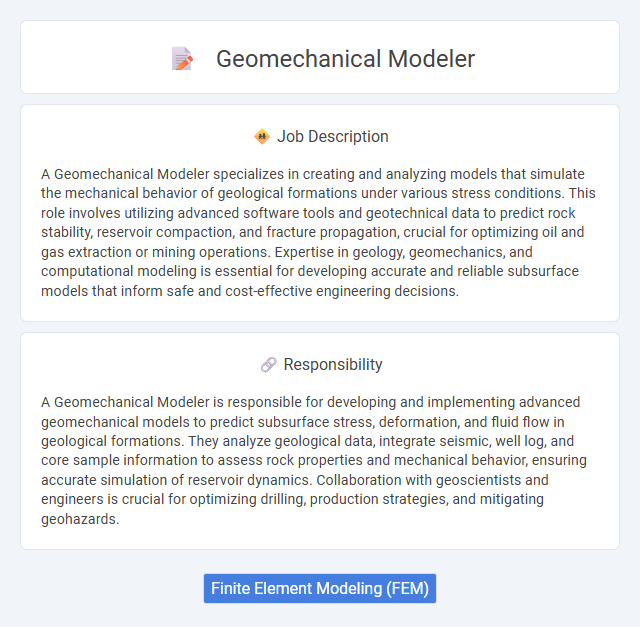
A Geomechanical Modeler specializes in creating and analyzing models that simulate the mechanical behavior of geological formations under various stress conditions. This role involves utilizing advanced software tools and geotechnical data to predict rock stability, reservoir compaction, and fracture propagation, crucial for optimizing oil and gas extraction or mining operations. Expertise in geology, geomechanics, and computational modeling is essential for developing accurate and reliable subsurface models that inform safe and cost-effective engineering decisions.
Individuals with strong analytical skills and a background in geology, engineering, or related fields will likely find the Geomechanical Modeler role well-suited to their abilities. People who enjoy working with complex data, computer simulations, and problem-solving in technical environments may be more inclined to thrive in this job. Those less comfortable with detailed modeling work or lacking interest in earth sciences might face challenges adapting to the role's demands.
Qualification
A Geomechanical Modeler requires a strong foundation in geology, geophysics, or petroleum engineering along with proficiency in geomechanical modeling software such as FLAC3D, Abaqus, or ANSYS. Expertise in interpreting rock mechanics data, fracture analysis, and reservoir geomechanics is essential to accurately simulate subsurface conditions. Advanced degrees in relevant fields and experience with wellbore stability, stress field analysis, and hydraulic fracturing assessment significantly enhance qualification for this role.
Responsibility
A Geomechanical Modeler is responsible for developing and implementing advanced geomechanical models to predict subsurface stress, deformation, and fluid flow in geological formations. They analyze geological data, integrate seismic, well log, and core sample information to assess rock properties and mechanical behavior, ensuring accurate simulation of reservoir dynamics. Collaboration with geoscientists and engineers is crucial for optimizing drilling, production strategies, and mitigating geohazards.
Benefit
A geomechanical modeler likely enhances exploration and production efficiency by accurately simulating subsurface rock behavior under various stress conditions. This role potentially reduces drilling risks and operational costs through improved prediction of geomechanical hazards. Employers may benefit from informed decision-making and optimized resource extraction due to precise modeling inputs.
Challenge
The geomechanical modeler job likely involves complex challenges related to interpreting subsurface data and predicting rock behavior under various stress conditions. Managing uncertainties in geological formations and integrating multidisciplinary datasets could present ongoing difficulties. Adapting models to real-world constraints may require continuous problem-solving and innovation.
Career Advancement
Geomechanical modelers develop and analyze subsurface earth models to optimize resource extraction and infrastructure stability, gaining expertise in rock mechanics, reservoir simulation, and data integration. Advancing in this career involves mastering advanced software tools such as Petrel and FLAC3D, as well as acquiring professional certifications like SPE Petroleum Engineering Certification. Senior roles include Leading geomechanics projects, contributing to multi-disciplinary teams, and driving innovation in predictive modeling to enhance decision-making in oil and gas or civil engineering sectors.
Key Terms
Finite Element Modeling (FEM)
Geomechanical modelers specialize in Finite Element Modeling (FEM) to analyze subsurface stress, deformation, and stability in geological formations. Utilizing FEM software, they simulate rock behavior under various conditions to optimize drilling, reservoir management, and geotechnical projects. Expertise in material properties, boundary conditions, and meshing techniques is essential to ensure accurate and reliable geomechanical predictions.
 kuljobs.com
kuljobs.com